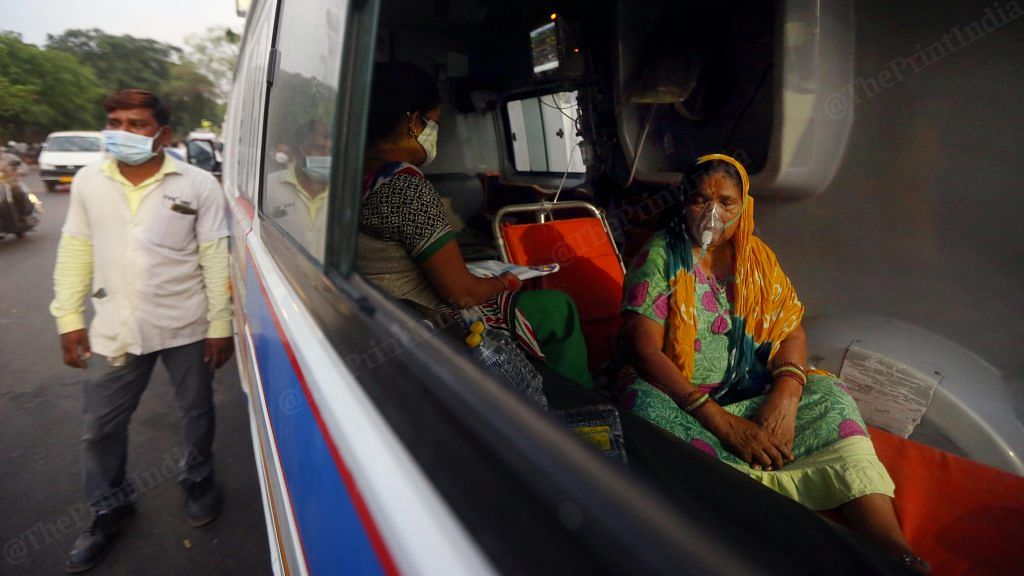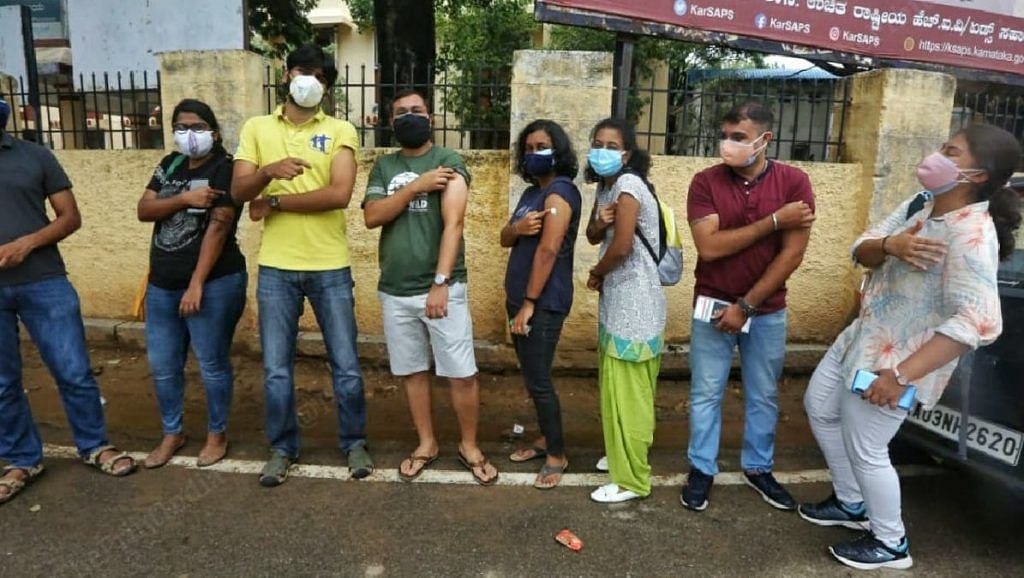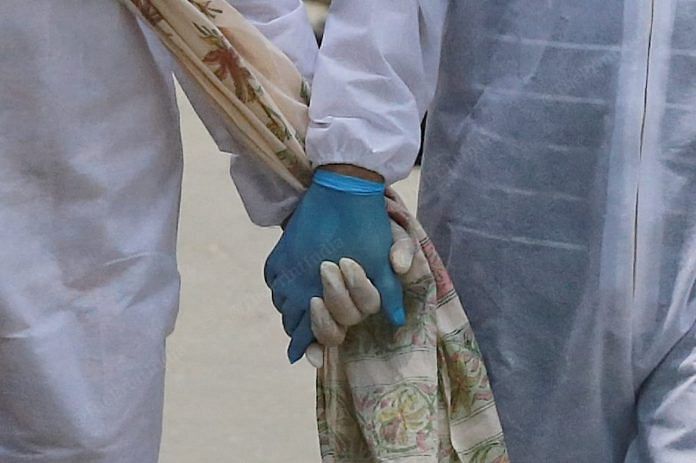‘Hit me’ — a popular toy that bounces back up every time one punches it — is what comes to mind when we think of the constant struggle between Covid, its variants from Delta to Omicron, vaccines and us.
It is hard to tell at this point if the toy is an analogy for the virus, or us.
From a 2021 that started with optimism, to surviving a devastating second wave and now facing a rise in cases once again with a new variant, Covid has not left the headlines — which is what makes it ThePrint’s Newsmaker of the Year. Now, with 2022 rolling, the focus should be on vaccinating, and not getting complacent again.
Also read: Delhi, Mumbai’s R value crosses 2 for first time since pandemic began, India’s climbs to 1.22
First, the lull
January 2021 started on a note of hope for India. With two effective vaccines already approved, and several more in the pipeline, the country started vaccinating its healthcare workers on 16 January.
The availability of vaccines within a span of a year itself was an unprecedented feat of scientific research. There was some scepticism initially among healthcare workers since data on the safety and efficacy of Covaxin was yet to be made public, but top doctors were among the first to get the dose and display their faith in the indigenously developed vaccine. Along with this, active cases were constantly falling, raising hopes that the pandemic was finally coming to an end. Restrictions were eased and life began to slowly go back to normal for some, but the fear of infection continued to linger.
The situation at the time gave rise to several theories about why India’s infection numbers and death numbers were not as high as that of the US, despite the population not being vaccinated. Despite opening up lockdown restrictions, India’s daily new cases continued to decline.
While some scientists postulated that the BCG vaccine — given for TB — had helped Indians stay protected from the disease, others said that Indians had a stronger immunity owing to the fact that they were, in general, more exposed to more pathogens than Western countries.
The Union health minister at the time, Harsh Vardhan, all but declared the end of the pandemic, hailing it as a success of the Narendra Modi government.
Several isolation facilities were rolled back in light of the low number of cases.
It was in this environment of optimism that state election campaigns were carried out without any caution or Covid protocols. Thousands of maskless people crowded Bengal election rallies. Along with this, keeping the upcoming UP elections in mind, the Modi government decided to permit the Kumbh Mela — a Hindu festival that saw participation of thousands of devotees.
As the ministry officials put it, Covid fatigue had set in — tired of being locked up in their houses for over a year, people began to abandon protocols. Weddings that had been postponed for a year now took place, and people indulged in what was called ‘revenge travel’. Gyms, restaurants and bars opened up. For a few weeks, the country was lulled into a feeling that the pandemic had indeed come to an end.
The early signs of a rise in cases began to come by late February. But with a West Bengal election scheduled for March, the PM’s attention was focussed elsewhere. Even as cases began to rise exponentially in various districts of Bengal, campaigns continued — and by the end of March as polls began, the devastating second wave had already hit the country.

Also read: India’s hope is ebbing. It needs a leader who focuses on health, not victory
Then the storm
As India crossed Brazil to become the country with the most number of cases worldwide, people soon realised in horror that not only were the number of hospital beds insufficient, Indian hospitals also lacked oxygen support critical for those struggling with severe Covid.
The idea that India was somehow an exception, that Indian were less vulnerable to the disease were nullified in days — and soon even the most privileged sections of the society began to realise that there were no hospital beds available. Every second people were tweeting about the requirement of oxygen, plasma, medicines. Soon, even hospitals were tweeting about oxygen running out.
An ugly war between state and central governments played out over the allocation of oxygen, even as black marketers took advantage of family members desperate to save the lives of their near and dear ones.
Lines for hospitals beds. Lines for medicines that ran low in stock. Lines for oxygen cylinders. And then lines for funerals. It shattered both rural and urban India.
At the time when the total number of daily deaths hit 2,000 on average, some of the most heartbreaking images of crowded crematoriums were seen from across the country. Late Reuters’ photographer Danish Siddiqui’s iconic aerial shot of a Delhi crematorium with numerous pyres angered many — not because of the complete failure of the government to prevent such a disaster, but because capturing such images allegedly hurt their religious sentiments.
In this crisis, there were those who could not afford to cremate the dead, and so India and the world saw horrifying visuals of the dead floating in the Ganga or buried in sandbanks. Such images are going to persist in collective memory for a long time to come.
Even as social media was flooded with requests for oxygen and medicines, the government continued to deny any shortage, losing precious time that could have been used to prevent another epidemic that followed — black fungus. By this time, research from around the world had showed that corticosteroids can lower the risk of death if given under specific conditions. But steroids lower the body’s immunity and make us vulnerable to infections that we are otherwise able to fight off, such as mucomyosis or black fungus. Many of those who survived severe Covid, then succumbed to black fungus.

Steps to disaster
There was a lot of reasons why India struggled to survive Covid in 2021.
Vaccinations for those with comorbidities over the age 45, and everyone over the age of 60 had been opened up by 1 March. But there was not much emphasis on scaling up the vaccination process despite the slow rise in cases.
The government also wanted to set an example of being the country coming in aid of others at a time of crisis. By 22 March, India had supplied 60.4 million vaccine doses to 76 countries through different modalities including grants in aid, gifts, commercially and through WHO-GAVI’s COVAX alliance, even as most of India’s own adult population could not take the vaccine.
Harsh Vardhan told Parliament at the time, “It is not necessary, scientifically, to give each and every person in the country the vaccine.”
It was only as India began to emerge out of the trauma of the second wave, did it open up vaccination for all adults — on 1 May. Then came the shortage of vaccines. Coping with losses of friends, family, and colleagues, Indians began to enthusiastically sign up for vaccinations — but once again, the Indian government appeared to be woefully underprepared.
Indians struggled to book slots for the vaccines on the CoWin that were short in supply. Once again, government officials continued to deny any supply shortages even as vaccine centres had to be shut down temporarily due to the lack of available doses.
Meanwhile, the Aam Aadmi Party ran a campaign saying “Humare baccho ki vaccine videsh kyun bhej di?”

Also read: How Corbevax and Covovax, the two vaccines newly approved in India, fight Covid
Delta to Omicron
Research soon showed that a new variant of the virus, which we now know as Delta, was behind India’s second wave. Caught unawares because of the low rate of genome sequencing carried out in India, the variant was not flagged in time for authorities to take note.
Although the first case of Delta was sequenced in India in late 2020, it was named only in May this year. It was when the delta variant hit other countries that we began to understand the variant through their research. In August, Public Health England (PHE) reported that it had increased transmissibility.
Delta caused a wave in the United Kingdom and a devastating wave in South Africa in June. By July, it had also driven an increase in daily infections in parts of the United States, Australia, and New Zealand.
Unlike India, South Africa rang the alarm bells for Omicron very early on. As a result, India was not caught unawares and even though cases are already on the rise, there is still time for stopping a devastating third wave. And our vaccinations have also risen.
Humanity is notorious for being stubborn and resilient. Amid the fear of Omicron, we usher in 2022 with about 63 per cent of Indians being fully vaccinated, 90 per cent having at least one dose of the vaccine — and the hope that ‘precaution doses’ will keep those at high risk protected from severe disease and deaths.
Views are personal.
(Edited by Neera Majumdar)



